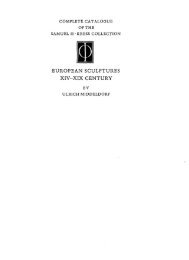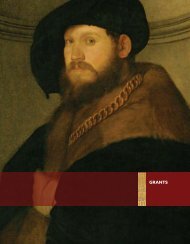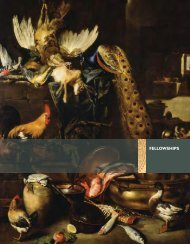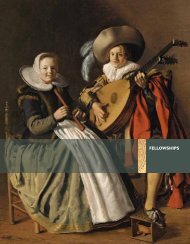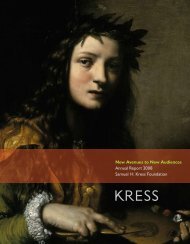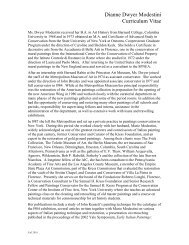The Campus Art Museum - Samuel H. Kress Foundation
The Campus Art Museum - Samuel H. Kress Foundation
The Campus Art Museum - Samuel H. Kress Foundation
You also want an ePaper? Increase the reach of your titles
YUMPU automatically turns print PDFs into web optimized ePapers that Google loves.
works in the campus museum as described by a professor at the University of<br />
Missouri:<br />
With students and my own kids—having been in Italy—they come into that<br />
room, that middle room and all of a sudden it’s just the gasps. “Wow! I’ve just<br />
seen this stuff in Italy.” We get students who have been studying abroad and<br />
there’s just this recognition and feeling that we’re not so far removed. We’ve got<br />
some of that stuff right here. And those are the kids who then end up having<br />
a better relationship long-term with the museum, I think, because they can<br />
connect it to all those great experiences. It’s really meaningful.<br />
Non-<strong>Art</strong> Curricula<br />
Although students and professors in art history and studio art appear to be those<br />
who interact consistently with the <strong>Kress</strong> Collections, professors and students in<br />
other disciplines also make use of the collections. Curators often include <strong>Kress</strong><br />
works in class sessions they set up for professors, as exemplified by a curator at<br />
IUAM who created a class titled “What do you think of immaculate conception?”<br />
for a religious studies professor. A curator at the AMAM, noting that the <strong>Kress</strong><br />
paintings are at the core of their Italian Renaissance and Baroque holdings, stated<br />
that they “outreach to art history and the Conservatory and then we want to<br />
involve other departments such as religion and history and even economics…. A<br />
beautiful portable altarpiece… has been used to look at trade routes.”<br />
At the University of Arizona, an area studies professor incorporates <strong>Kress</strong><br />
works into an essay option for his students. A history professor there is planning to<br />
use the Retablo in his Mexican history class:<br />
I want to focus on popular religion in Mexico, I mean the way popular religion<br />
has developed so this is going to be fabulous… I just read an article about the<br />
catechism written by Padre Ripalda. He wrote it right around the time of the<br />
Council of Trent. It was translated into Italian, then translated into Spanish and<br />
this catechism remained the basic catechism in Mexico and most of the rest of<br />
Latin America from that time until about 1940… I want to know things from<br />
this catechism that are reflected visually and this [museum] is one of the places<br />
where they will find them. Along with that, the author of this article… talks<br />
about how people in Mexico grew up learning this catechism and if they read<br />
anything else, it was not the Bible because that was discouraged…, so if they<br />
read anything else or knew anything else about Biblical ideas it came from<br />
Dante’s Inferno, very early translated into Spanish and circulated in Mexico. For<br />
my seminar this coming Monday, we are going to discuss the article, we are<br />
going to discuss the catechism of Padre Ripalda, and they also have to read<br />
Dante’s Inferno…. And then we will have this chance to look and see things….<br />
And it makes it more striking and memorable to be able to use the <strong>Kress</strong><br />
Collection and have them go up and look for what they’ve just read about.<br />
<strong>Kress</strong> works have been used as inspiration for dance movements, as noted by<br />
a curator at the Spencer: “We’ve had people do dance gesture projects that related to<br />
Research and Curriculum<br />
16



